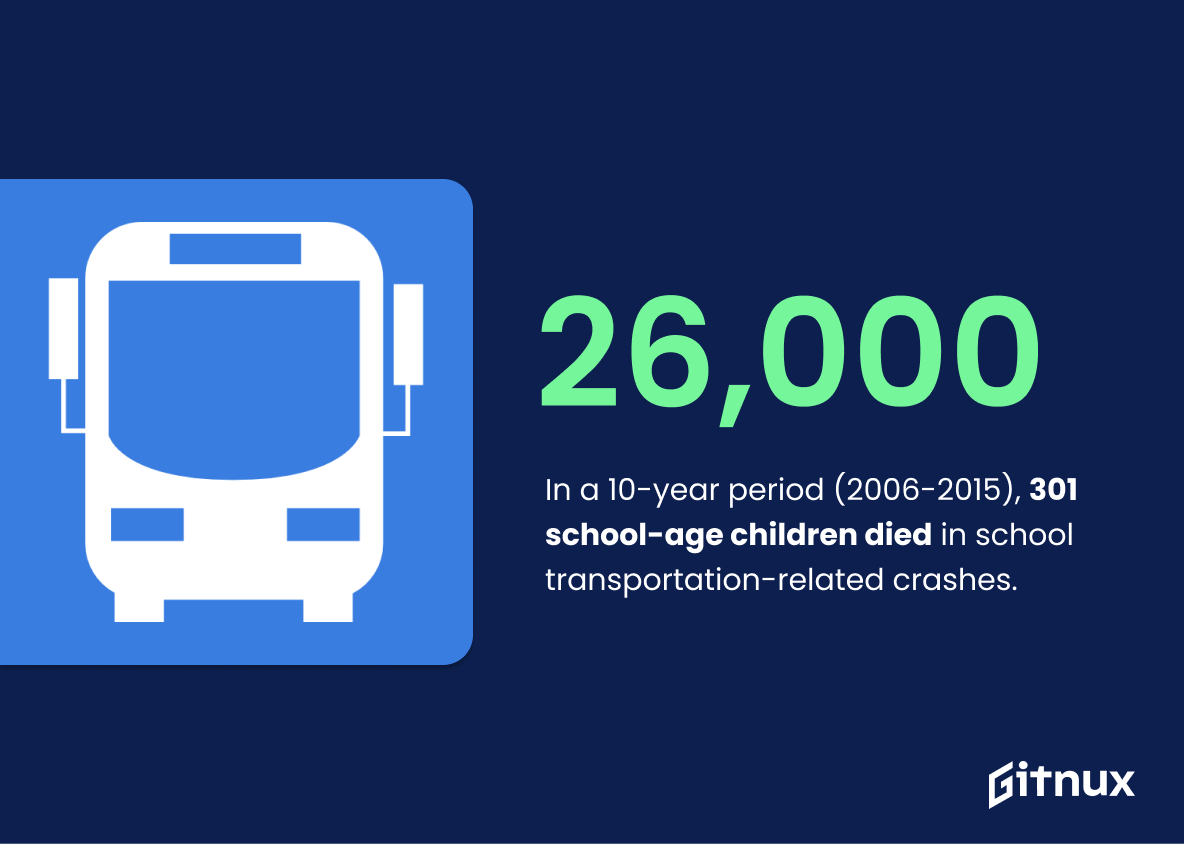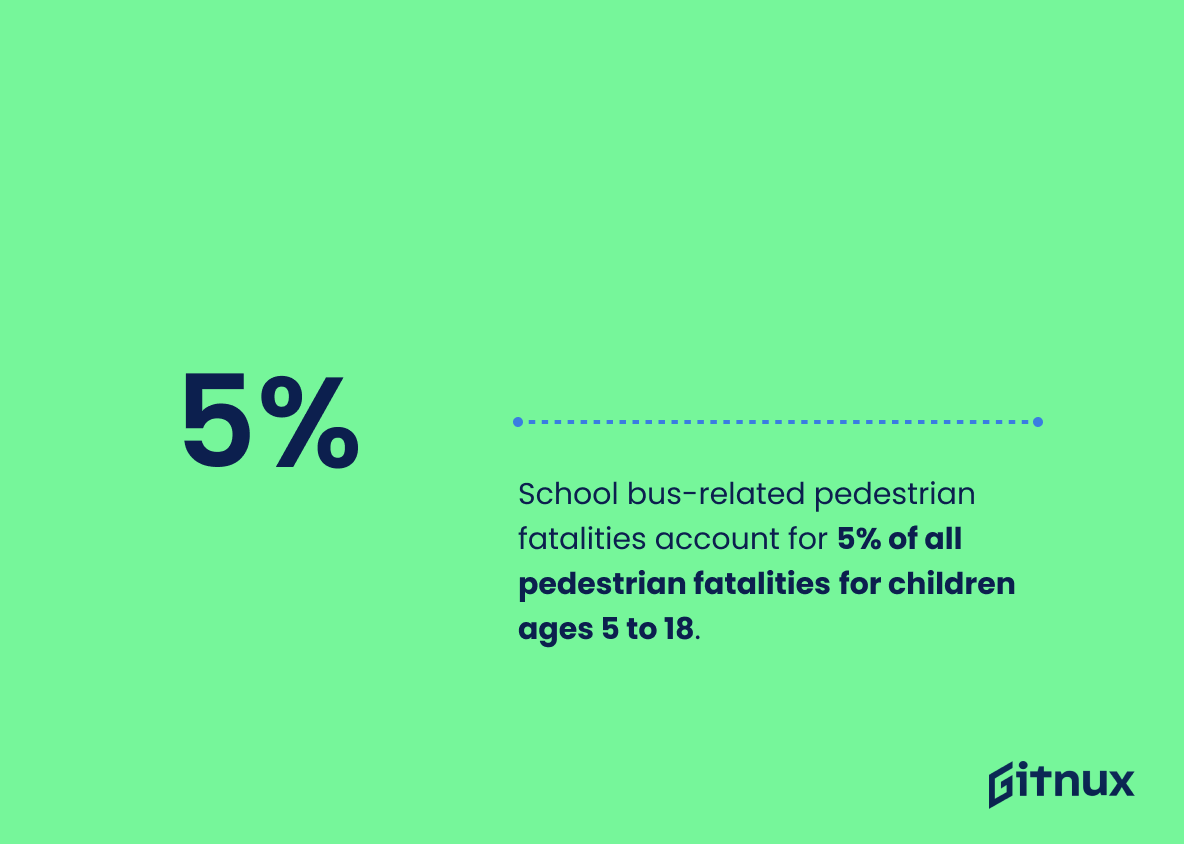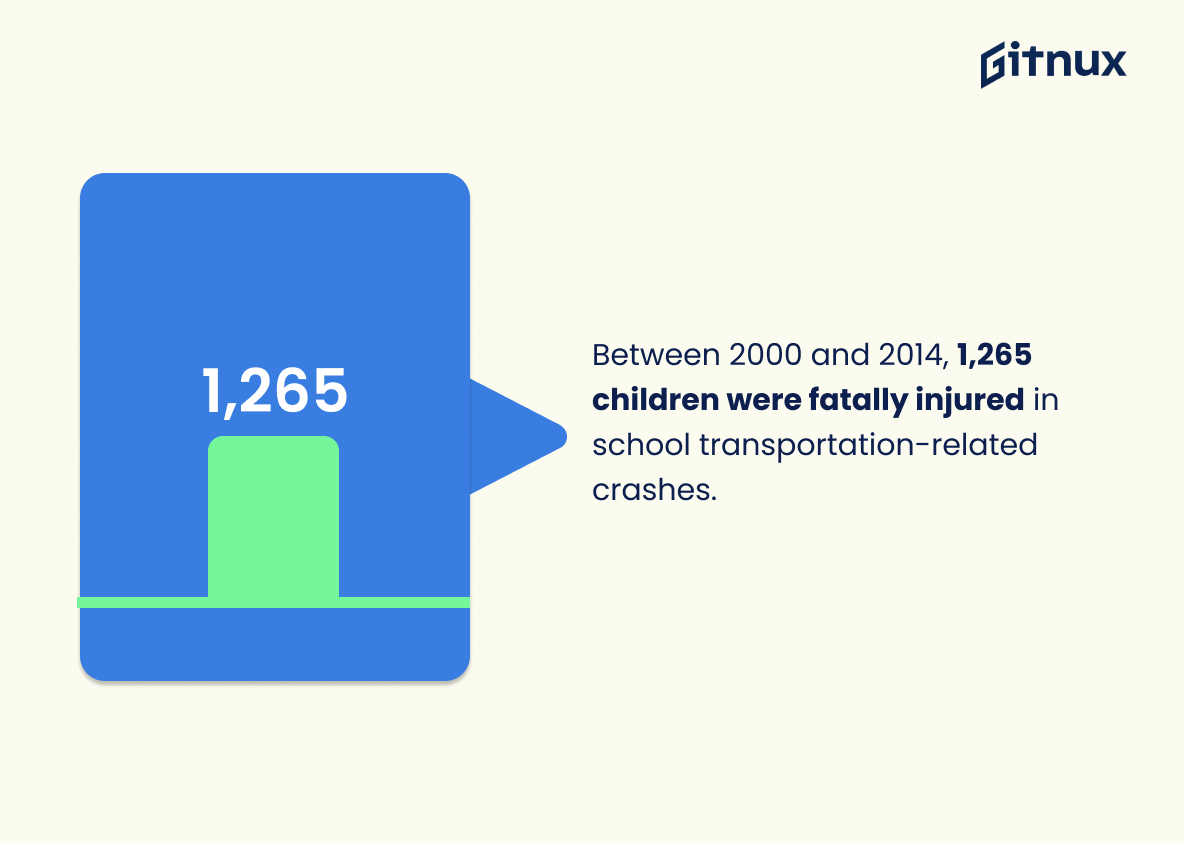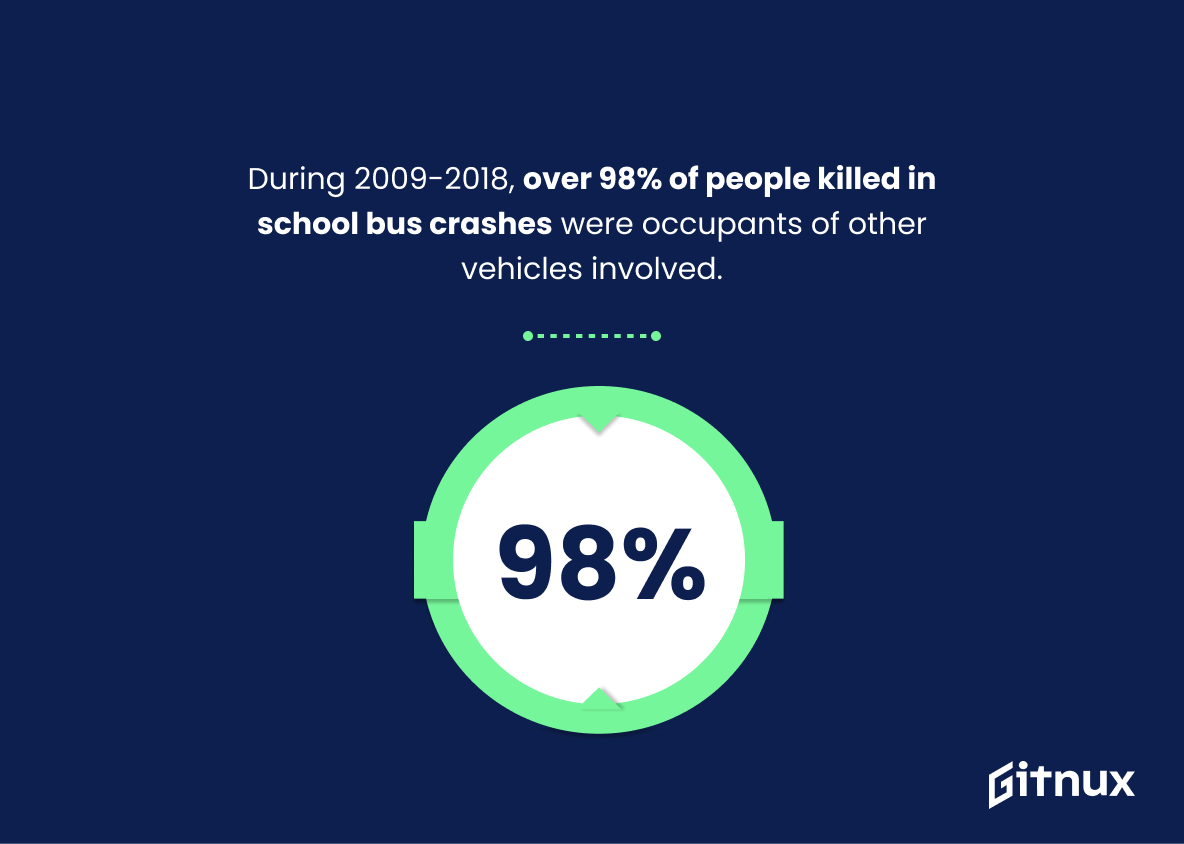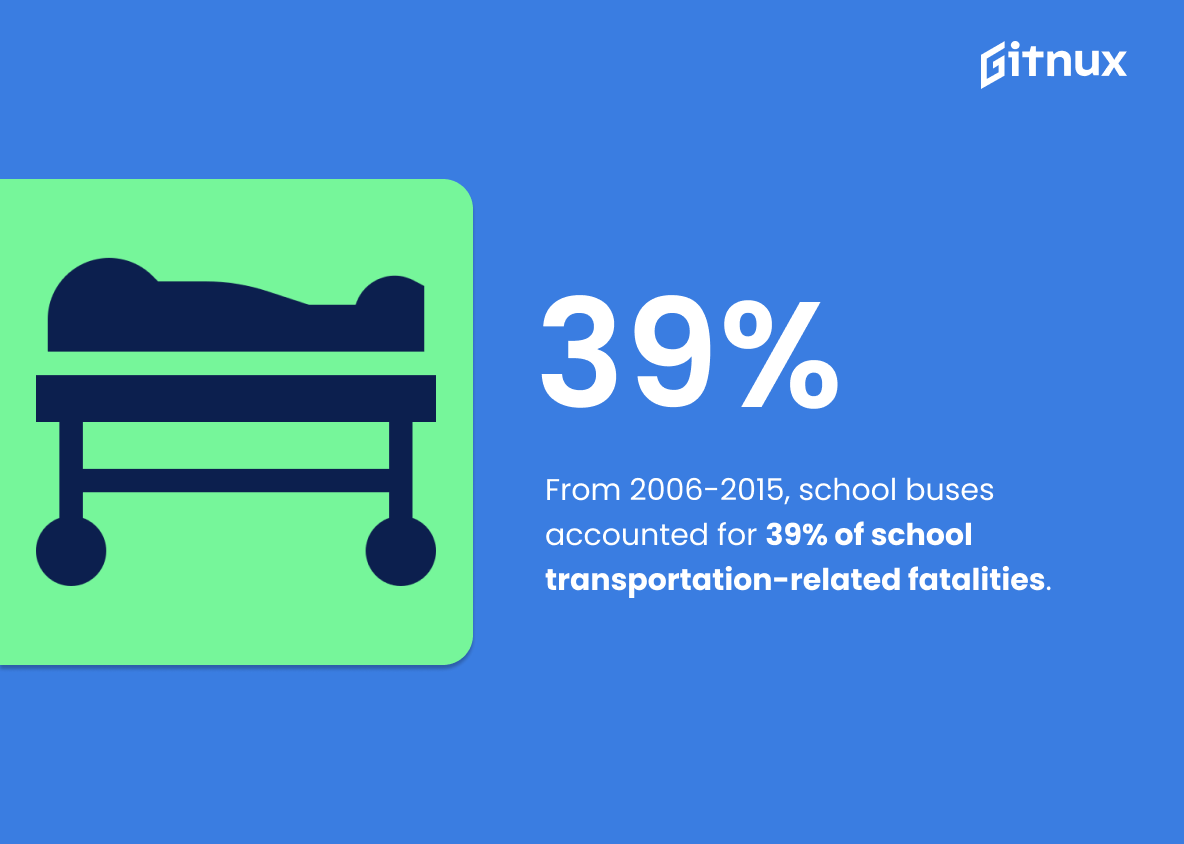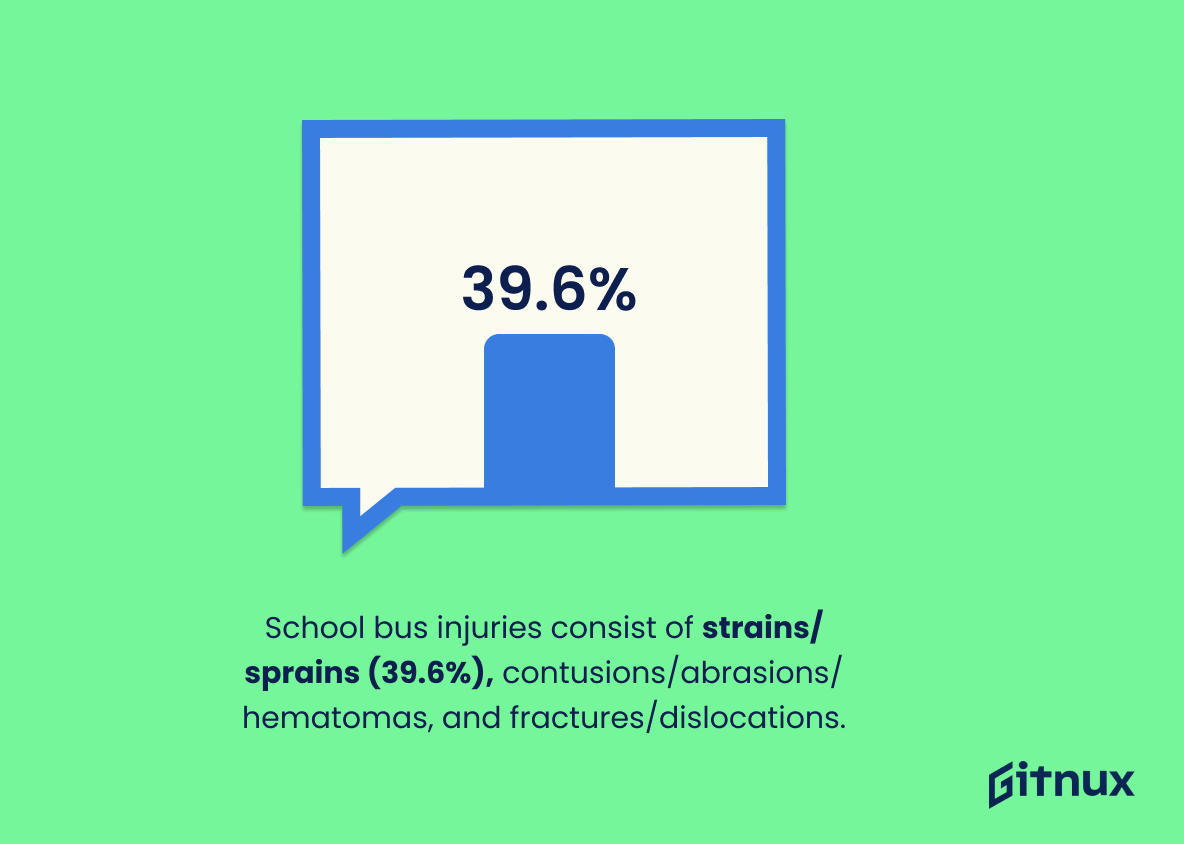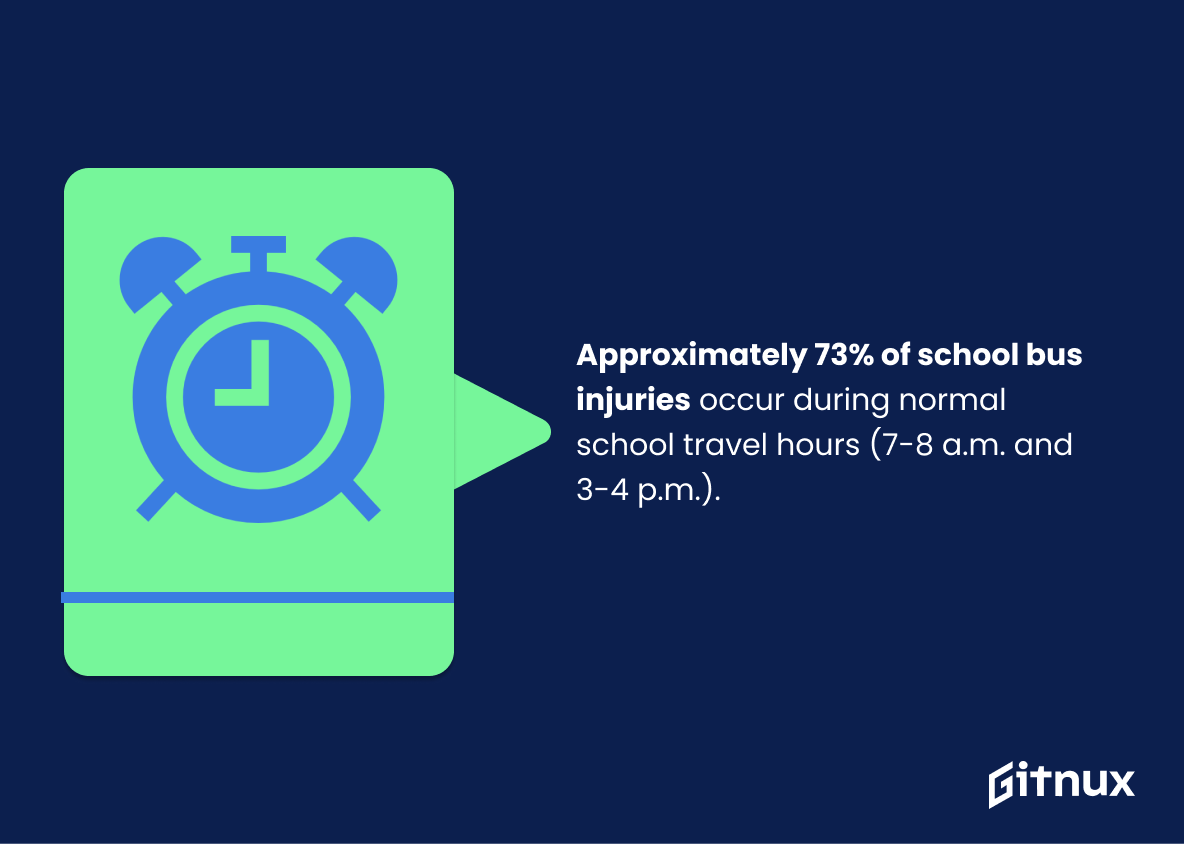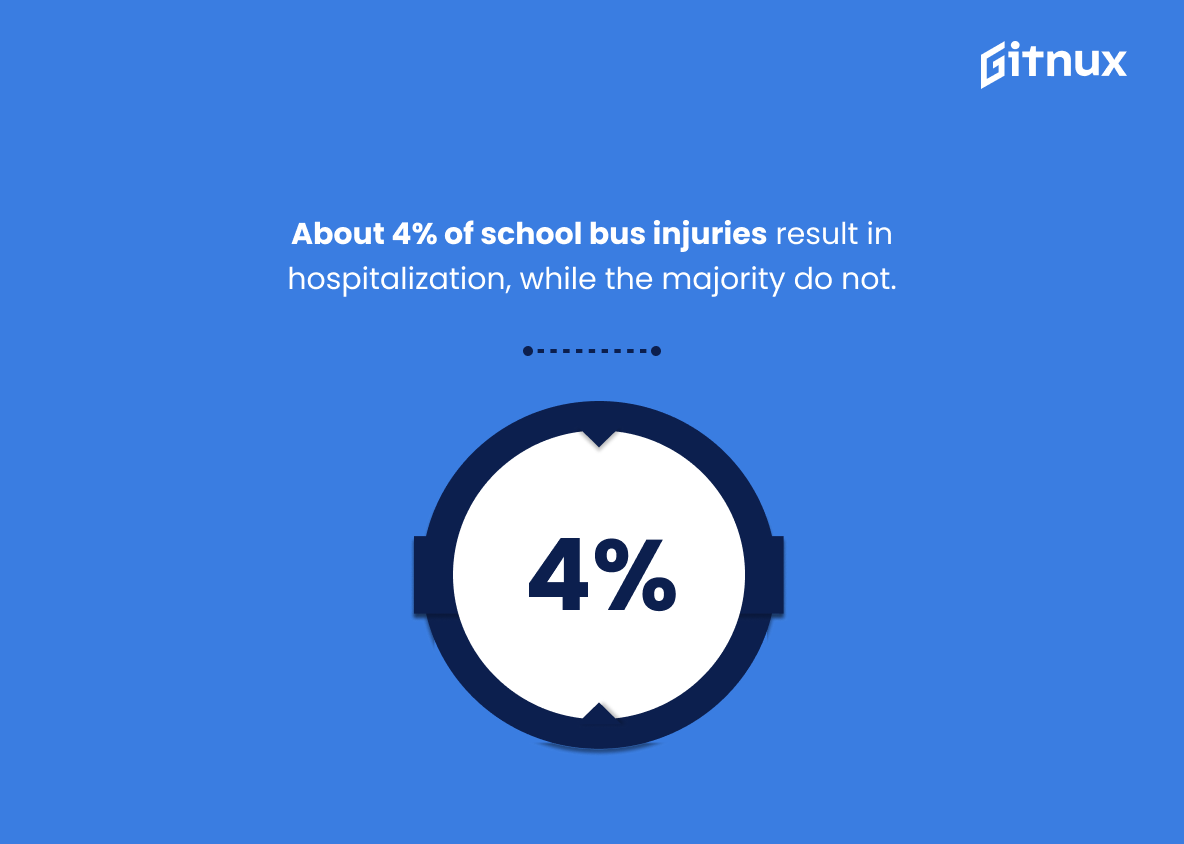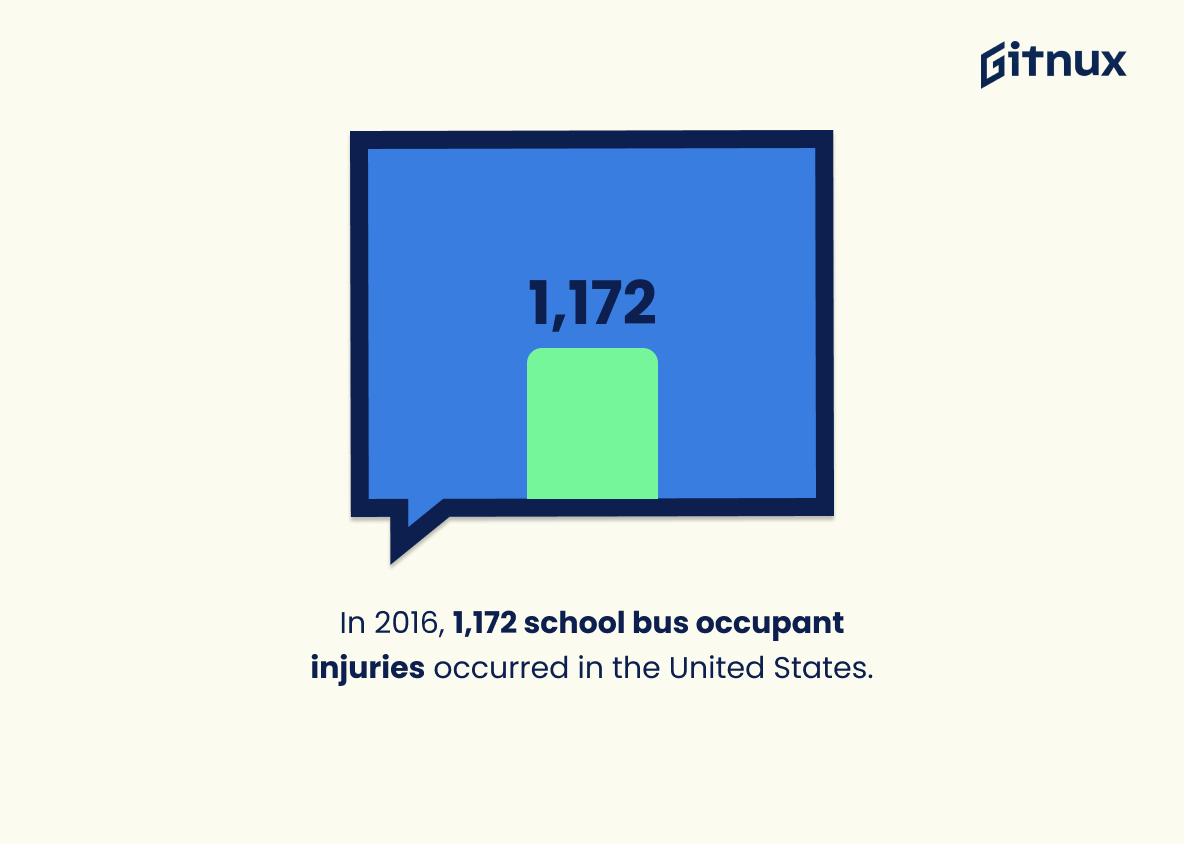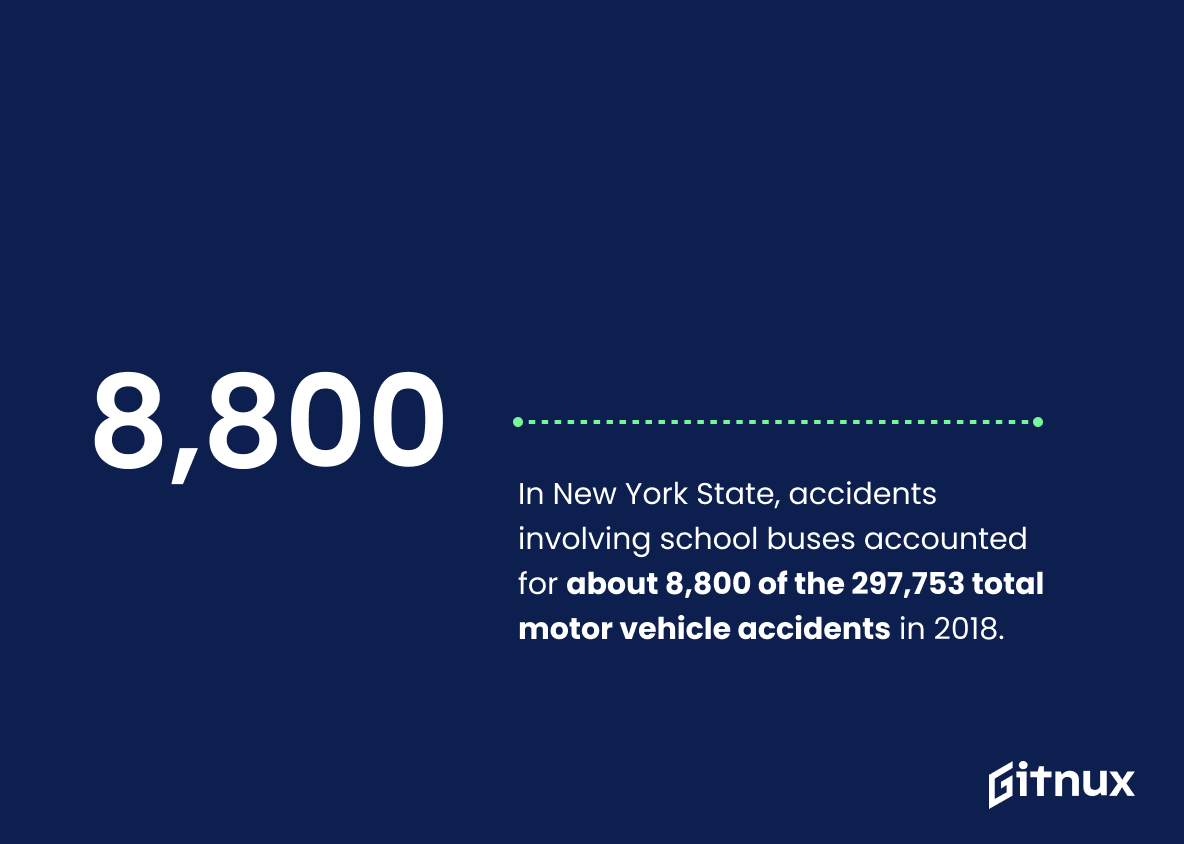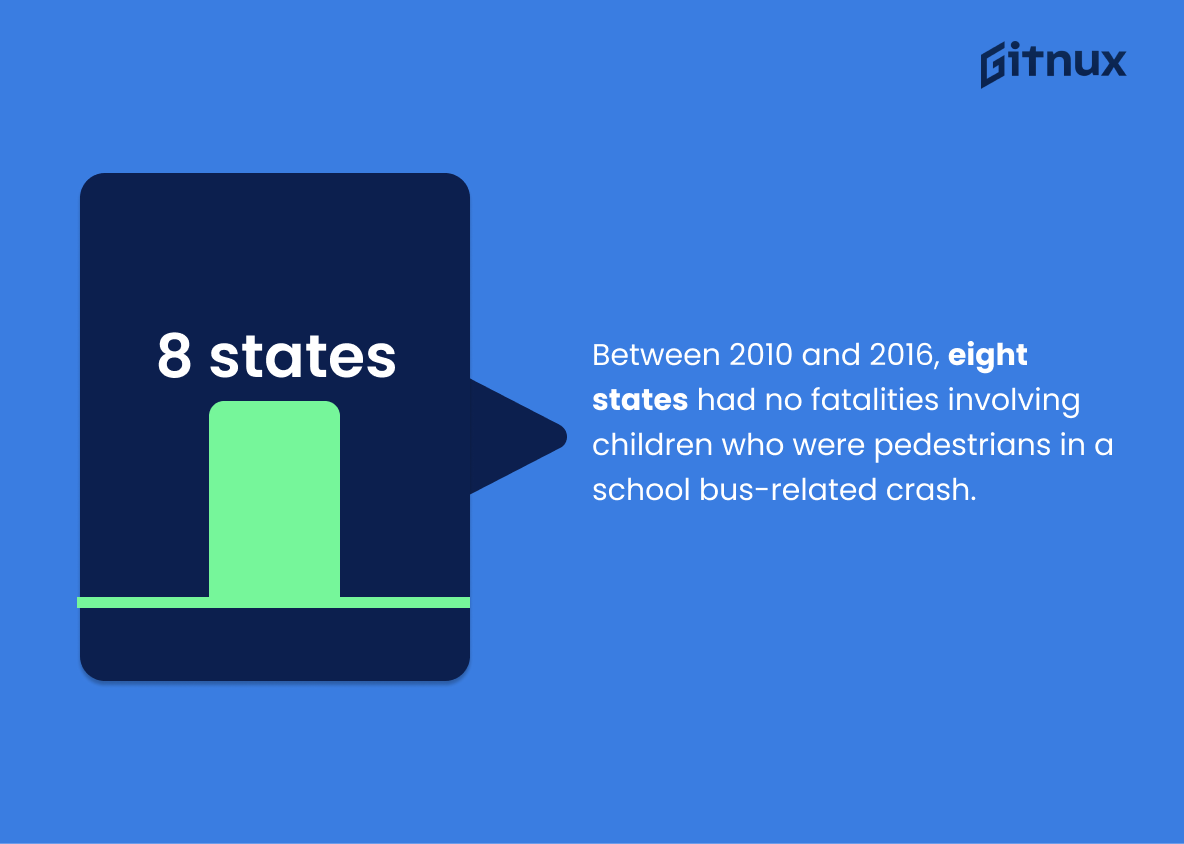School bus-related injuries are a serious issue in the United States, with an estimated 26,000 children suffering school bus-related injuries annually. Approximately 12% of these incidents involve children getting on or off the bus and 54% result from auto accidents involving the buses themselves. In addition to this, 42% of fatal crashes involving school buses occur at their front end while 5% of all pedestrian fatalities for those aged between five and eighteen are related to school busses.
In a ten year period (2006 – 2015), 301 people died as a result of such transportation-related crashes; 1,265 were fatally injured between 2000 and 2014; 98 percent killed in 2009 – 2018 were occupants of other vehicles involved; 39 percent fatalities occurred due to school busses during 2006 – 2015; 73 percent happened during normal travel hours (7am – 8am & 3pm – 4pm); 11 percent resulted in injury overall but only four per cent required hospital admission; eight states had no child pedestrian deaths over 2010–2016 according to NHTSA data and 53.5 per cent Kentucky School Bus Accidents took place on dry roads between 2003–2013 whilst 134 people died each year across 2004–2013 nationwide due to similar causes.
This blog post will explore these statistics further by looking into what can be done about them as well as examining how they have changed over time so that we can better understand why they exist today and how best we can prevent future occurrences from happening again.
School Bus Injuries Statistics Overview
In a 10-year period (2006-2015), 301 school-age children died in school transportation-related crashes.
This statistic is a stark reminder of the dangers of school transportation-related crashes and the tragic consequences they can have. It serves as a reminder that we must remain vigilant in our efforts to ensure the safety of our children while they are travelling to and from school.
42% of school-bus related fatal crashes involve the front of the bus.
This statistic is a stark reminder of the dangers that school buses can pose. It highlights the importance of taking extra precautions when driving around school buses, as the front of the bus is the most vulnerable area in the event of a crash. It also serves as a warning to parents and students to be aware of the risks associated with riding a school bus.
School bus-related pedestrian fatalities account for 5% of all pedestrian fatalities for children ages 5 to 18.
This statistic is a stark reminder of the dangers that children face when crossing the street near a school bus. It highlights the importance of taking extra precautions when children are in the vicinity of a school bus, as even a small percentage of fatalities can have a devastating impact on families and communities.
Between 2000 and 2014, 1,265 children were fatally injured in school transportation-related crashes.
This statistic is a stark reminder of the dangers of school transportation-related crashes, highlighting the need for increased safety measures to protect children while they are travelling to and from school. It serves as a call to action for parents, school administrators, and lawmakers to take steps to ensure that children are kept safe while travelling to and from school.
During 2009-2018, over 98% of people killed in school bus crashes were occupants of other vehicles involved.
This statistic is a stark reminder of the dangers of sharing the road with school buses. It highlights the fact that the vast majority of those killed in school bus crashes are not the students or drivers on the bus, but rather the occupants of other vehicles. This underscores the importance of being extra cautious when driving near school buses, as the consequences of a collision can be devastating.
From 2006-2015, school buses accounted for 39% of school transportation-related fatalities.
This statistic is a stark reminder of the dangers of school bus transportation. It highlights the need for increased safety measures to protect students and other passengers from the risks of school bus-related fatalities. It also serves as a call to action for parents, educators, and policy makers to take steps to ensure that school buses are as safe as possible.
School bus injuries can include strains or sprains (39.6%); contusions, abrasions or hematomas (26.9%); and fractures or dislocations (11.8%).
This statistic is a crucial piece of information when it comes to understanding the prevalence of school bus injuries. It reveals that strains or sprains are the most common type of injury, followed by contusions, abrasions or hematomas, and then fractures or dislocations. This information is essential for parents, school administrators, and other stakeholders to be aware of in order to take the necessary steps to ensure the safety of students while riding the school bus.
School bus injuries are most frequently sustained by children between 10 and 14 years old.
This statistic is a crucial indicator of the need for increased safety measures for school-aged children. It highlights the fact that children between the ages of 10 and 14 are particularly vulnerable to injury while riding the school bus, and that steps must be taken to ensure their safety. By understanding this statistic, we can better understand the risks associated with school bus travel and take the necessary steps to protect our children.
Approximately 73% of school bus injuries occur during normal school travel hours (7-8 a.m. and 3-4 p.m.).
This statistic is a stark reminder of the dangers of school bus travel during peak hours. It highlights the need for increased safety measures during these times, such as improved driver training, better vehicle maintenance, and stricter enforcement of traffic laws. It also serves as a warning to parents and guardians to be extra vigilant when their children are travelling to and from school.
The majority of school bus-related injuries do not require hospitalization, with only about 4% involving hospital admission.
This statistic is a crucial piece of information when it comes to school bus injuries, as it reveals that the vast majority of such incidents do not require hospitalization. This means that the severity of the majority of school bus-related injuries is relatively low, and that the risk of serious injury is relatively low. This is an important point to make in a blog post about school bus injuries statistics, as it can help to reassure parents and other stakeholders that the risk of serious injury is low.
Between 2006 and 2015, 2.5% of children killed in school transportation-related crashes were occupants of school buses.
This statistic is a stark reminder of the dangers of school transportation-related crashes, and the importance of taking steps to ensure the safety of children on school buses. It highlights the need for improved safety measures, such as better driver training and improved vehicle design, to reduce the risk of injury and death for children on school buses.
In 2016, 1,172 school bus occupant injuries occurred in the United States.
This statistic serves as a stark reminder of the potential dangers of school bus travel. It highlights the importance of taking the necessary precautions to ensure the safety of school bus occupants. It also serves as a call to action for parents, school administrators, and lawmakers to take steps to reduce the number of school bus occupant injuries in the future.
In New York State, accidents involving school buses accounted for about 8,800 of the 297,753 total motor vehicle accidents in 2018.
This statistic is a stark reminder of the prevalence of school bus accidents in New York State. It highlights the fact that, out of the nearly 300,000 motor vehicle accidents in 2018, a significant portion of them involved school buses. This is an alarming statistic that should be taken seriously, as it indicates that school bus safety is an issue that needs to be addressed.
Between 2010 and 2016, eight states had no fatalities involving children who were pedestrians in a school bus-related crash.
This statistic is a testament to the progress that has been made in keeping children safe while they are on or near school buses. It shows that, in eight states, the efforts of parents, school administrators, and law enforcement have been successful in preventing any fatalities involving children who were pedestrians in a school bus-related crash. This is an encouraging sign that, with the right measures in place, school bus-related injuries can be prevented.
Conclusion
School bus-related injuries are a serious issue in the United States, with an estimated 26,000 children suffering from such incidents annually. About 12% of these injuries involve getting on or off the bus and 54% result from auto accidents involving the school bus. In addition, 42% of fatal crashes involve the front of the school buses and 5% are pedestrian fatalities for children ages 5 to 18. Over 98 percent of people killed in school bus crashes were occupants of other vehicles involved between 2000 and 2014 while 39 percent were related to transportation-related fatalities over a 10 year period (2006 – 2015).
Injuries sustained by those riding on or near a schoolbus can range from strains/sprains to fractures/dislocations; most commonly occurring among 10-14 year olds during normal travel hours (7am – 8am & 3pm – 4pm). The majority do not require hospitalization but 1,172 occupant injuries occurred in 2016 alone across America. Furthermore, eight states had no reported child pedestrian deaths due to schoolbus related incidents between 2010 and 2016 while 53.5 %of Kentucky’s 2003–2013 accidents happened on dry roads according to one study conducted there . Finally ,1 ,344 people died as part of this statistic between 2004 – 2013 averaging 134 per annum .
It is clear that safety should be paramount when it comes travelling via School Bus both for passengers themselves as well as pedestrians nearby who may also be at risk if proper precautions aren’t taken
References
0. – https://www.www.nhtsa.gov
1. – https://www.pubmed.ncbi.nlm.nih.gov
2. – https://www.www.fmcsa.dot.gov
3. – https://www.www.newyorkmotorinsurance.com
4. – https://www.www.researchgate.net
5. – https://www.www.usatoday.com
6. – https://www.www.consumerreports.org
7. – https://www.crashstats.nhtsa.dot.gov
8. – https://www.injuryfacts.nsc.org
9. – https://www.injuryprevention.bmj.com
